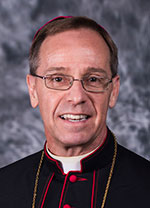Christ the Cornerstone
Jesus became a man so we might be transformed in God’s image

“Our citizenship is in heaven, and from it we also await a savior, the Lord Jesus Christ. He will change our lowly body to conform with his glorified body” (Phil 3:20-21).
The Gospel readings for the first two Sundays of Lent offer us contrasting images of Jesus, the Son of God and Son of Mary.
Last week, we were presented with Jesus in his weakest and most vulnerable condition as a man. After fasting in the desert for 40 days and nights, he was hungry, tired and probably very lonely (Lk 4:1-13).
The devil, who is the father of lies and the master of deceit, insinuates himself into the mind of Jesus and attempts to persuade him to abandon his mission and his fidelity to his Father in heaven. Jesus successfully resists the temptations of the devil, but we have to imagine that it was an exhausting process for him. Only the agony in the garden, and his passion and death, will be more demanding.
The Gospel for this weekend, the Second Sunday of Lent (Lk 9:28b-36) provides a very different portrait of Jesus. Here we are given a glimpse of our Lord in all his glory:
“While he was praying, his face changed in appearance and his clothing became dazzling white. And behold, two men were conversing with him, Moses and Elijah, who appeared in glory and spoke of his exodus that he was going to accomplish in Jerusalem” (Lk 9:29-31).
What Jesus will accomplish in Jerusalem is the transformation of all humanity from a people enslaved to the powers of darkness to a people who have been forgiven and redeemed by the passion, death and resurrection of God’s only Son. The transfiguration we witness (with Peter, James and John) in this Sunday’s Gospel is a foretaste of Easter joy. It is a prophetic vision of what will happen to Jesus—and to all who are faithful to him—in the resurrection from the dead.
The presence of Moses and Elijah in today’s Gospel reading is an affirmation of the fulfillment of God’s promise to Abraham in the first reading from the Book of Genesis (Gn 15:5-12, 17–18). This promise is both spiritual and material. The descendants of Abraham are God’s chosen people, and he has given them the promised land as their inheritance. Through his incarnation, Christ not only shares in the spiritual and material blessings of this promise, he also fulfills God’s covenant with Abraham by his sacrifice on the cross accomplished in Jerusalem at the time of his passion, death and resurrection.
In the second reading from the Letter to the Philippians (Phil 3:17-4:1), St. Paul tells us that we, too, are chosen by God and that, as a result, “our citizenship is in heaven and from it we also await a savior, the Lord Jesus Christ” (Phil 3:20).
Our destiny, St. Paul says, is to one day be like Christ “who will change our lowly body to conform with his glorified body by the power that enables him also to bring all things into subjection to himself” (Phil 3:21). In other words, at the end of time, if we have remained faithful to God’s commands, our bodies will be transformed like the resurrected body of Jesus.
The transfiguration of the Lord is an epiphany, a manifestation of the Triune God—Father, Son and Holy Spirit—who loves us so much that God gives himself to us unreservedly to save us from our selfishness and sin. All God asks in return is that we listen to him, encounter him, and discern his will for us. This is the threefold purpose of our Lenten journey, and it is especially meaningful now as we prepare for a worldwide synod in October 2023 whose theme is synodality itself: communion, participation and mission.
Jesus became a man and exposed himself to both the devil’s lies and the cruelty of his fellow men, so that we might be freed from the power of sin and death and one day be transformed in body and soul. The prophetic vision that is revealed in Sunday’s Scripture readings is that you and I, and all our sisters and brothers everywhere, are called to be like the resurrected Jesus—transformed by the power of the Holy Spirit so that our lowly bodies conform with Christ’s glorified body in the joy of eternal life.
As we continue our Lenten journey, let’s give thanks to God for all his gifts. Let’s also ask God to help us prepare for the joy of Easter and for the life we have been promised in the resurrection of the dead and the life of the world to come. †
